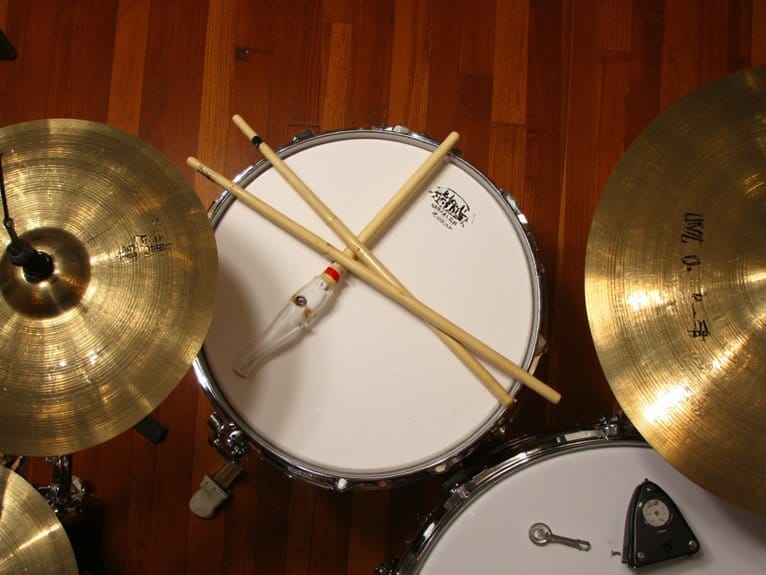Useful Tips and Insights for Drummers
You’ll dramatically improve your drumming by focusing on timing fundamentals with metronome practice at slow tempos, developing proper stick control through the four stroke types and Moeller technique, and building limb independence with simple eighth-note patterns before advancing to complex polyrhythms. Master sound quality by understanding how stick positioning affects tonal output, maintain consistent contact pressure for uniform energy transfer, and structure daily practice into focused fifteen-minute segments rather than marathon sessions. These foundational principles unveil advanced techniques that separate confident players from struggling beginners.
We are supported by our audience. When you purchase through links on our site, we may earn an affiliate commission, at no extra cost for you. Learn more.
Notable Insights
- Practice with a metronome at slow tempos (40-50 BPM) and count out loud to develop precise internal timing and eliminate flams.
- Master the four stroke types (full, down, tap, up) with relaxed grip mechanics to enable expressive and efficient drumming technique.
- Structure practice into focused 15-minute segments with warm-ups, rudiments, and metronome work rather than lengthy marathon sessions.
- Develop limb independence by starting with simple eighth-note patterns and gradually adding bass drum variations and polyrhythmic complexity.
- Strike different drum locations (center vs. edge) and maintain consistent contact pressure to control tonal output and sound quality.
Building a Solid Foundation With Timing and Basic Techniques
While many drummers rush to learn flashy fills and complex patterns, I’ve found that building exceptional timing and mastering basic techniques creates the foundation that separates good players from truly great ones.
Start with controlled timing exercises using quarter and eighth note combinations on hi-hat, kick, and snare-honestly, I spent months perfecting these seemingly simple rhythm patterns before attempting anything fancy.
Practice with a metronome, then challenge yourself by shifting clicks to off-beats or reducing them to once per bar, which reveals whether you’re rushing or dragging. For an even greater challenge, try practicing at extremely slow tempos like 50 or even 40 BPM, where the wide spaces between clicks will truly test your internal timing. Count out loud while playing, maintain relaxed stick grip, and focus on eliminating flams between simultaneous notes.
You can even practice these timing exercises without a full drum kit-a simple practice pad or pillow works perfectly for developing your sense of rhythm and subdivision accuracy. Many modern electronic drum sets include built-in metronomes and training modes that can help structure your practice sessions and provide immediate feedback on your timing accuracy.
These fundamentals might seem boring, but they’ll transform your playing.
Mastering Advanced Stick Control and Movement Methods
Once you’ve developed rock-solid timing and basic technique, the next logical step involves understanding how your sticks actually move and behave in your hands-something I wish someone had explained to me years ago when I was struggling with inconsistent dynamics.
Mastering stick vibration starts with loosening your grip just enough to feel that subtle “tickle” or “hum” when the stick hits the drum, which indicates you’re not choking the sound.
Dynamic control comes from understanding four stroke types: full strokes for loud playing, down strokes that shift from loud to quiet, tap strokes for soft passages, and up strokes that prepare for louder hits.
Combining these with compound stickings and proper grip mechanics creates the foundation for expressive, musical drumming. Just as dynamic microphones excel in high sound pressure environments during live performances, your stick control must adapt to different playing intensities and venues.
The Moeller technique revolutionizes efficiency by grouping cyclical wrist motions into sets of 2, 3, or 4 strokes that enable high-speed playing with significant power. Emphasizing rebounding strokes between your hands helps condition the muscles for more effortless and relaxed movement while building essential dexterity.
Achieving Superior Sound Quality Through Proper Drumhead Contact
After spending countless hours fine-tuning stick technique, I’ve learned that achieving professional-quality drum sounds depends equally on understanding how your sticks interact with the drumhead surface-a concept that transformed my playing once I grasped the physics behind proper contact.
Your stick positioning dramatically affects tonal output, with center strikes producing deeper fundamentals and edge hits creating brighter attack characteristics. Contact pressure consistency guarantees uniform energy transfer, while strategic head selection complements your striking approach-thinner single-ply heads respond differently than dampened two-ply constructions.
Strategic stick placement and consistent contact pressure create the foundation for professional drum tone, with head selection amplifying these fundamental striking principles.
Through deliberate sound exploration, you’ll discover how subtle pitch adjustment occurs when varying strike locations, and proper tuning techniques amplify these effects. The vibrations create an air column that affects sound waves between the heads, fundamentally altering your drum’s resonance characteristics. The shell shape influences your drum’s internal acoustics and contributes significantly to the overall tone you achieve.
Mastering drumhead contact isn’t just about technique; it’s about understanding how every strike shapes your sonic signature.
Effective Practice Strategies for Continuous Improvement
Three fundamental pillars transform casual drum sessions into powerful skill-building experiences: structured routine development, consistent time management, and deliberate technique refinement-principles I’ve watched countless drummers overlook while wondering why their progress stagnates.
You’ll maximize growth by breaking practice into 15-minute focused segments, starting with effective warm ups on practice pads before shifting to the kit.
I’ve found that incorporating metronome work at varying tempos, combined with rudiments and foot ostinatos, develops essential limb independence that separates intermediate players from advanced ones.
Creative grooves emerge when you experiment with different subdivisions-8ths, 16ths, triplets, and shuffles-while maintaining consistent foot patterns. Engaging with the music community provides valuable motivation and collaboration opportunities that fuel continued growth.
Recording sessions for self-analysis, though initially uncomfortable, reveals timing inconsistencies you’ll never catch otherwise, accelerating improvement through objective feedback. Establishing a dedicated practice area maintains motivation and eliminates distractions that undermine focused skill development.
Developing Limb Independence and Coordination Skills
Building on those practice fundamentals, limb independence represents the single most challenging aspect of drumming that I’ve encountered-the ability to make each limb operate as its own rhythmic entity while your brain simultaneously coordinates four distinct musical voices.
Start your coordination training with simple eighth-note patterns on the snare, establishing that steady foundation before introducing bass drum variations. I recommend split paradiddles between hands and feet, which force each limb to maintain distinct sticking patterns without interference from others.
Practice away from your kit initially, tapping surfaces to develop isolated muscle memory. Begin slowly, focusing on consistent repetitions rather than speed, and gradually layer complexity as your neural pathways strengthen. Visualize exercises in your mind before attempting them physically to enhance muscle memory development.
The exercise becomes adaptable beyond basic patterns, allowing you to explore sixteenth notes and different surfaces like floor toms to expand your coordination vocabulary.
Short daily sessions of ten minutes consistently outperform marathon practice sessions for building lasting limb independence.
On a final note
You’ve got the building blocks now-timing fundamentals, advanced stick techniques, proper contact methods, smart practice routines, and limb independence drills. I’ve seen countless drummers transform their playing by focusing on these core areas, and honestly, the difference is night and day when you commit to consistent work. Don’t rush the process; your muscle memory needs time to develop these skills properly, but you’ll notice improvement within weeks of dedicated practice.







